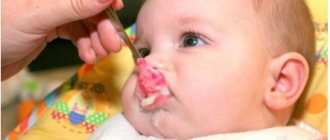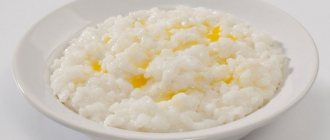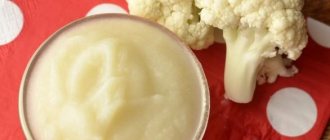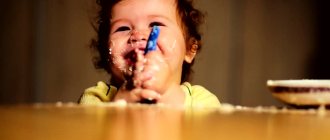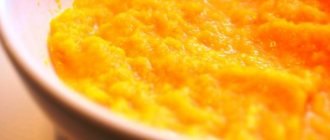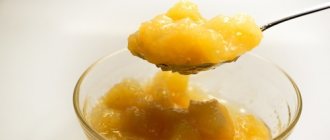Your baby is growing up, getting stronger, gaining weight, and then there comes a time when feeding only breast milk or formula is not enough for the full development of the baby. The time has come to introduce complementary foods into your child's diet. The question arises - where to start? Your pediatrician should answer this.
Today we’ll talk about how to properly introduce complementary foods with cereals. We'll talk about how to breed porridge, which one is better to choose for the first feeding, and how homemade porridge differs from store-bought ones.
Porridge for children under one year old
Porridge contains the entire necessary set of microelements, is perfectly digestible, and has a beneficial effect on the digestive system.
Usually, porridge begins to be introduced into a baby’s diet at the age of six months. If the child is bottle-fed, it is permissible to start earlier, at 4-5 months. These are only approximate dates; in fact, everything is individual. The rate of development of the child, his readiness for adult food and his tendency to allergic reactions should be taken into account.
Feeding cereals is recommended for children who are not gaining weight well. Most likely, the baby simply does not have enough calories. In any case, before starting complementary feeding, you should consult a pediatrician. He will help you choose porridge, tell you in what quantities and how often to feed your child with it.
It is important that the first porridge is:
- Industrial production
. Not only because the raw materials are sterilized and undergo rigorous quality control. But also because at home it is difficult to achieve such a degree of grinding of cereals as porridge manufacturers do. For example, Materna porridge consists of delicate cereal flakes, which form an absolutely homogeneous mass when brewed. If desired, they can be diluted to a thick mixture and offered to the baby to drink from a bottle. - One-component
. To trace the cause of an allergic reaction if it occurs.
Which dairy-free cereals are best for first feeding?
Choosing the first porridge for complementary feeding
To ensure that the child does not experience discomfort from the introduction of new food into the diet, when choosing the first complementary food, you need to be guided by several rules.
Important: pediatricians recommend industrial dairy-free products, since they are sterilized in production and are better processed, especially for baby food. At the same time, the industrial product is perfectly balanced, which is difficult to achieve at home.
One-ingredient food
One-component dairy-free porridge for complementary feeding
Porridge should be chosen according to age. For children under seven months, it is best to choose porridge from three grains:
- rice;
- buckwheat;
- corn.
This choice is due to the fact that these cereals do not contain gluten. This substance is of plant origin, but in most cases can cause stomach upset or severe allergies. In this case, a special sign will be drawn on the packaging: a crossed out spikelet. If this is not available, you need to carefully read the composition.
Several cereals
Dairy-free 8-grain porridge
After seven months, a child can be given porridges made from several grains. Previous use of the “mix” can lead to allergies. In this case, it is difficult to determine which grain the baby is allergic to.
Age restrictions
A certain grain must be given at a certain age so that the child does not have problems with the digestive system.
It is best to follow these tips:
- up to seven months you can give: rice, buckwheat or corn;
- from eight oats and wheat groats are introduced;
- from nine months it is allowed to give pearl barley and barley;
- after a year, manna groats are allowed.
Adding fruit
Pediatricians recommend consuming fruits after six months. Exceptions may be apples or pears. If the child is not allergic, then it is allowed to add fruit after heat treatment.
How to properly organize complementary feeding with cereals
For the first acquaintance, you need to prepare five percent porridge, which means that for five grams of dry porridge there should be 100 mg of water. The resulting consistency will be ideal for a child who does not yet know how to chew and swallow thick food.
The best time to introduce complementary foods is the morning meal. This way you will have time to track your baby’s reaction to the new product: whether there is an allergy or bowel disorder.
For feeding, use a baby spoon made of safe material for the baby’s delicate gums or a regular teaspoon.
As a first test, it is enough to give the child about half a tablespoon of liquid porridge. The baby must try the new product and get used to the change in consistency and taste.
Make sure the porridge is not too cold or hot and does not contain any lumps.
After porridge feeding, feed your baby his usual food - breast milk or formula.
Increase the serving size of porridge only when you are sure that your baby eats it with pleasure and does not experience any unwanted reactions.
Every day, increase the volume of porridge by spoon until the portion is 150 g for a six-month-old baby, 160-170 g for a child aged 7-8 months and 170-180 g for a child aged 8-9 months. Closer to the year, the serving size will be about 200 g. And the five percent porridge will be replaced by a thicker, ten percent one.
We remind you that these are only general recommendations, and the development of each child is individual and the dosage may differ from that described above. It is important not to change cereals at the beginning of complementary feeding; your baby should get used to one cereal, and only after a successful debut can you offer the next one - no earlier than two weeks later.
If you start experimenting ahead of time and give your child a different porridge every day, in the event of an allergy, it will be very difficult for you to understand what exactly the child’s body reacted to.
Why dairy-free cereals for first feeding?
For the baby's first complementary feeding, porridge without milk is suitable, since the baby receives the necessary elements contained in milk from mother's milk or formula. This is enough for the little one to get into the body:
- casein;
- vitamin D;
- alpha-lactalbumin;
- oleic acid and so on.
The second important factor when choosing a dairy-free product can be considered the child’s individual tolerance. There are children who are lactose intolerant or allergic to any dairy product. Also, porridge without milk will help to avoid upset, colic or bloating, since milk can ferment in the stomach. In this case, soy protein isolate or milk protein hydrolysate included in such cereals will be an excellent alternative to milk. They are completely safe and hypoallergenic.
The child does not eat porridge
Kids refuse porridge for various reasons.
- Don't like the taste or consistency. It happens that children who started complementary feeding with fruits and vegetables do not eat porridge, because their taste is very different and is not so bright. Try adding a familiar apple or broccoli to a new porridge. In addition, a child may not like the taste of some cereal today, but in a couple of weeks he will be happy to eat it. Put this mess aside for a while and try again later.
- The porridge is too hot or cold. Check the temperature of food on the inside of your wrist. If you do not feel cold or hot, then the temperature is optimal.
- The baby is not hungry yet. Set the plate aside for half an hour and then try again.
The main advice to parents is not to despair and offer the same porridge many times in different combinations.
How to make dairy-free porridge for first feeding
Dairy-free cereals can be diluted with: breast milk, formula and water. There are basic cooking rules:
- maintaining personal hygiene;
- the dilution liquid should not be more than 50 degrees;
- When pouring liquid into the dry cereal mixture, you need to continuously stir the porridge so that lumps do not form (it is better to use a fork);
- proportions are 1:5, that is, one serving of industrial cereals 4-5 servings of water, the mother chooses the consistency herself.
- The amount of liquid is the same as for breast milk, formula and water.
How to prepare dairy-free porridge for first feeding at home
Cooking dairy-free porridge at home
For those who do not want to buy industrial ready-made cereals for the baby’s first complementary feeding or do not have the opportunity to buy packaging, you can prepare the first complementary feeding at home. Of course, homemade porridge will not be as balanced as factory-made, but it’s better than nothing. To prepare porridge at home you need to follow a few tips and rules.
- Selection of raw materials. If you decide to cook at home, it is best to use buckwheat or rice. They boil well.
- Preparation. To cook the cereal, it must go through several stages:
- cleansing (you need to sort out the cereal);
- washing;
- drying;
- grinding (you can use a coffee grinder or blender).
Tip: you don’t have to grind the raw cereal, but do it when it’s ready.
After this, you can start cooking; for this, use baby water or boiled water. For the first feeding, it is recommended to cook very thin porridge. To do this, take cereal and water in the ratio: 5 grams of raw materials per hundred grams of water, gradually increasing the amount of cereal. The porridge is poured only into cold water, then “boiled” over moderate heat.
Advice: if the cereal has been ground in advance, then it is introduced into the water gradually, mixing well so that lumps do not form.
It is not recommended to add salt or butter to the finished porridge (only a little olive oil is allowed). You can add a little breast milk or formula if your baby refuses to try unusual foods.
Which porridge should be introduced first into complementary foods?
Be sure to contact your pediatrician for advice on which porridge to give your baby first. After all, all children are different.
The main types of cereals recommended for consistent inclusion in a child’s diet:
- Buckwheat porridge. It is considered indispensable in a child’s diet. Contains vitamins B1 and B2, iron, magnesium, protein.
- Rice porrige. Contrary to the common misconception of many parents, baby rice porridge will not cause constipation, because it does not contain crushed rice. To make these porridges, rice flour is used, which has a beneficial effect on the child’s digestion and is rich in healthy dietary fiber.
- Corn porridge. This porridge is a leader among other cereals in terms of potassium content. Also contains large amounts of protein, iron and fiber.
- Oatmeal. No other porridge compares to oatmeal in terms of fat and fiber content. In addition, oatmeal is rich in vegetable protein and calcium, iron, magnesium, vitamins B1, B2, PP. Oatmeal is introduced last of all the described porridges, because it is very rare, but allergies do occur.
Materna's product line includes dairy-free and dairy porridges for children from 4 to 6 months. All porridges do not contain salt and sugar and are made from cereals and fruits grown in Israel specifically for baby food.
Materna Shop is the only official online store in Russia that sells Materna baby food with delivery from a warehouse in Moscow.
Is it possible to dilute baby milk porridge with formula?
A special feature of children's milk porridges is the high content of milk powder. Thanks to this, the nutritional value of the product is good; adding the mixture is not necessary, although doctors do not prohibit it. Before preparing complementary foods for your baby, it is recommended to study the instructions - they indicate the proportions, it says whether the mixture can be used in preparation or whether it is better to limit it to boiled water.
There is one definite plus in preparing milk porridge using the mixture - the taste of the dish for the baby is significantly improved. The nutritional value also increases, but if the child is overweight, it is better not to overuse the nutrients.
When preparing complementary foods for your baby, you must follow the preparation rules specified by the manufacturers. Each composition contains vitamin complexes, which, under the influence of hot temperatures, can be destroyed. It's easy to avoid this - use only warm mixture or water.
The best dairy-free porridge for first feeding
On the baby food market you can find a huge number of manufacturers and, accordingly, baby food. The rating for dairy-free cereals for first feeding is, of course, compiled by young parents themselves, based on the preferences of their children.
Each manufacturer tries to surprise its consumers, but some of them are losing ground, inferior in quality and raw materials. Of course, the price is also different. The higher the quality, the higher the price.
On the market you can purchase a relatively inexpensive product, but of normal quality, which will meet all Russian standards.

